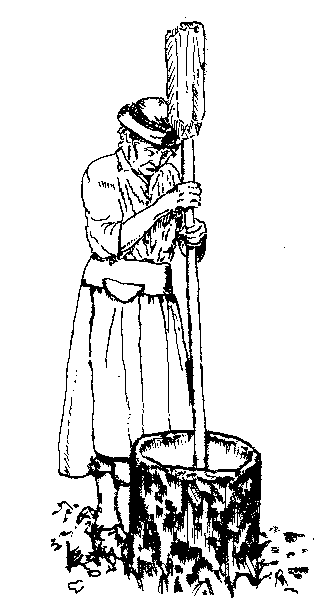
Mortars and Pestles
by Edward Moore
Back to the Texas Indians home page at WWW.TexasIndians.com
I am posting this a little early because of all the e-mails I receive asking for information on mortars and pestles. I am working on a longer article on Indian food processing.
Mortars and pestles were used to grind seeds and nuts into meal. A mortar is like a bowl and a pestle is a blunt stick or stone you hold to push or pound the seeds or nuts in the mortar. Meal is the ground up nuts. The Indians used this meal much like we use flour today. They mixed it with water and made bread with it. This was probably flat bread and looked like tortillas do today. In fact corn tortillas are an ancient form of American Indian bread.
Mortars and pestles come in many sizes. The Caddo and Cherokee used big ones they called corn mills. The mortar was made from a tree trunk. Here is a picture of one. The pestle here is the big thing that looks like a paddle. The Cherokee lady here lifts the pestle up and then pounds it down on the corn or acorns in the tree stump mortar. There is a good Caddo myth about a magical corn mill on the Caddo page. Click here if you want to read it.

Another common mortar and pestle the Indians in Texas used is the bedrock mortar. Bedrock mortars are mostly found in the Texas Hill Country. They are all found associated with pre-historic artifacts so we are not sure which tribe was using them. My best guess would be the ancestors of the Tonkawa made and used them. These are smaller and were used mostly to grind up acorns. They probably also used them to grind up other kinds of seeds. Here is a picture of several mortars all in the same rock.
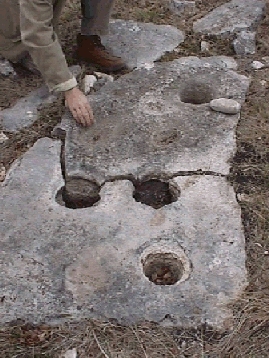
You can see the pestle laying at the top of the rock. This is a stone pestle. Here is a closer picture of it.
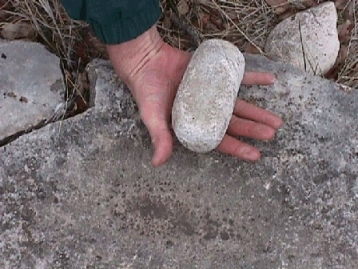
And here is someone showing how it all works.
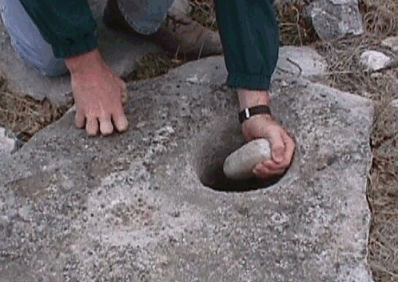
Using a small rock pestle like this was probably a lot a work. The Indians are smart enough to know how to do this more easily. An Indian woman would have used a stick about the size of a baseball bat to pound up and down with. Grinding meal was woman's work.
The Indian women would start with a natural hole or depression in the rock. After hundreds of years of use the hole would get deeper and deeper. Some of the hole in this rock were used till they went right through the rock!!!
The Indians who used these bedrock mortars and pestles did not have corn. They were using acorns. They would also use pecans and other nuts when they could get them. But other nuts did not need to be ground up to eat. Acorns did need to be ground. read on to find out why.
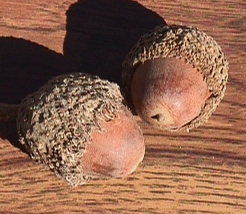
Crack these open like a nut and there is a nice white kernel inside.
Raw acorns have stuff in them that is very bitter and tastes awful. This stuff is tannic acid. To eat them you have to get the tannic acid out of them. This is why they were ground up instead of being eaten whole and raw. After grinding the meal was taken to a stream or to water. The meal was placed in a basket or in cloth. In some places they would make a shallow bowl in the sand and place the meal in that. Water was then poured over the meal over and over and would soak through the meal and wash out the tannic acid.
The meal was then dried and stored or cooked like bread or tortillas.
Acorns are not a very good food source for several reasons. The main reason is that they have little nutritional value. They are very low on fat. To us this sounds good. But Indians living off the land had a hard time getting fat into their diet. Animals provided most of the fat they ate. But, buffalo, deer and other wild game is very low in fat compared to our modern beef and pork. Acorns also take a lot of work to eat as we have seen. Nuts like pecans are loaded with fat and are much more nutritious than acorns. So the fact that these Indians were using acorns so much tells us they were living in an environment where food was a little hard to come by.
For more information on Indian food go to our Indian Recipes page
Copyright by R. Edward Moore and Texarch Associates, 2000, all rights reserved. Graphics may not be used or reproduced without prior permission. Short parts of text may be quoted in school reports. Longer quotes require prior written permission.